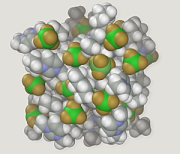

An ionic liquid (IL) is a salt in the liquid state at ambient conditions. In some contexts, the term has been restricted to salts whose melting point is below a specific temperature, such as 100 °C (212 °F).[1] While ordinary liquids such as water and gasoline are predominantly made of electrically neutral molecules, ionic liquids are largely made of ions. These substances are variously called liquid electrolytes, ionic melts, ionic fluids, fused salts, liquid salts, or ionic glasses.[2][3][4]
Ionic liquids have many potential applications.[5][6] They are powerful solvents and can be used as electrolytes. Salts that are liquid at near-ambient temperature are important for electric battery applications, and have been considered as sealants due to their very low vapor pressure.
Any salt that melts without decomposing or vaporizing usually yields an ionic liquid. Sodium chloride (NaCl), for example, melts at 801 °C (1,474 °F) into a liquid that consists largely of sodium cations (Na+
) and chloride anions (Cl−
). Conversely, when an ionic liquid is cooled, it often forms an ionic solid—which may be either crystalline or glassy.
The ionic bond is usually stronger than the Van der Waals forces between the molecules of ordinary liquids. Because of these strong interactions, salts tend to have high lattice energies, manifested in high melting points. Some salts, especially those with organic cations, have low lattice energies and thus are liquid at or below room temperature. Examples include compounds based on the 1-ethyl-3-methylimidazolium (EMIM) cation and include: EMIM:Cl, EMIMAc (acetate anion), EMIM dicyanamide, (C
2H
5)(CH
3)C
3H
3N+
2·N(CN)−
2, that melts at −21 °C (−6 °F);[7] and 1-butyl-3,5-dimethylpyridinium bromide which becomes a glass below −24 °C (−11 °F).[8]
Low-temperature ionic liquids can be compared to ionic solutions, liquids that contain both ions and neutral molecules, and in particular to the so-called deep eutectic solvents, mixtures of ionic and non-ionic solid substances which have much lower melting points than the pure compounds. Certain mixtures of nitrate salts can have melting points below 100 °C.[9]
- ^ Wilkes, John S. (2002). "A Short History of Ionic Liquids—from Molten Salts to Neoteric Solvents". Green Chemistry. 4 (2): 73–80. doi:10.1039/b110838g.
- ^ Thomas Welton (1999). "Room-Temperature Ionic Liquids" (PDF). Chem. Rev. 99 (8): 2071–2084. doi:10.1021/cr980032t. PMID 11849019.
- ^ Freemantle, Michael (2009). An Introduction to Ionic Liquids. Royal Society of Chemistry. ISBN 978-1-84755-161-0.
- ^ MacFarlane, Douglas; Kar, Mega; Pringle, Jennifer M. (2017). Fundamentals of ionic liquids : from chemistry to applications. Weinheim, Germany: Wiley-VCH. ISBN 9783527340033.
{{cite book}}: CS1 maint: multiple names: authors list (link) - ^ Shiflett, Mark (2020). Commercial Applications of Ionic Liquids. Green Chemistry and Sustainable Technology. Cham: Springer. doi:10.1007/978-3-030-35245-5. ISBN 978-3-030-35244-8. S2CID 211088946.
- ^ Greer, Adam; Jacquemin, Johan; Hardacre, Christopher (2020). "Industrial Applications of Ionic Liquids". Molecules. 25 (21): 5207. doi:10.3390/molecules25215207. PMC 7664896. PMID 33182328.
- ^ D. R. MacFarlane; J. Golding; S. Forsyth; M. Forsyth & G. B. Deacon (2001). "Low viscosity ionic liquids based on organic salts of the dicyanamide anion". Chem. Commun. (16): 1430–1431. doi:10.1039/b103064g.
- ^ J. M. Crosthwaite; M. J. Muldoon; J. K. Dixon; J. L. Anderson & J. F. Brennecke (2005). "Phase transition and decomposition temperatures, heat capacities and viscosities of pyridinium ionic liquids". J. Chem. Thermodyn. 37 (6): 559–568. doi:10.1016/j.jct.2005.03.013.
- ^ Mixture of nitrate salts with m.p. below 100 deg C